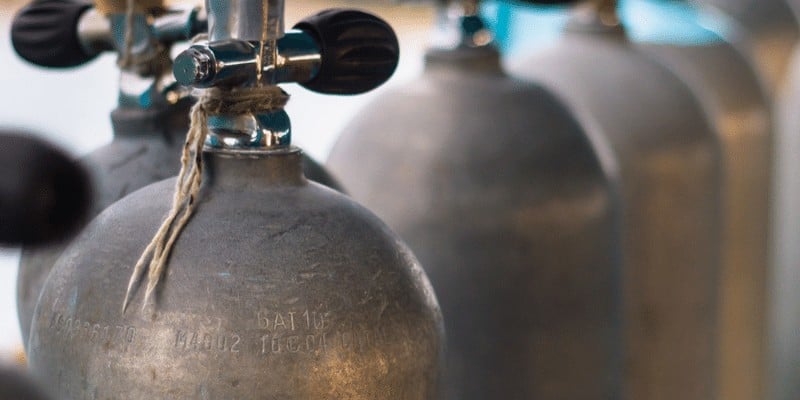Oxygen tanks are a common form of medical equipment used to provide oxygen to people with respiratory conditions.
Properly disposing of oxygen tanks is important both for safety reasons and to ensure that environmental regulations are met.
In this article, we will discuss why it is important to properly dispose of oxygen tanks, how to safely dispose of them, and the local and federal regulations for oxygen tank disposal.
What are Oxygen Tanks?
Contents
- 1 What are Oxygen Tanks?
- 2 Why is Disposing of Oxygen Tanks Important?
- 3 How to Safely Dispose of Oxygen Tanks
- 4 Local and Federal Regulations for Oxygen Tank Disposal
- 5 Different Types Of Oxygen Tanks And Their Disposal Requirements
- 6 Common Misconceptions about Oxygen Tank Disposal
- 7 Common Hazards Associated With Oxygen Tank Disposal
- 8 Best Practices For Oxygen Tank Disposal
- 9 Conclusion
Oxygen tanks are pressurized containers that store pure oxygen gas.
They come in many sizes, from small portable tanks for home use to large industrial-grade tanks.
Oxygen tanks are typically made from aluminum or steel and contain a regulator valve that controls the flow of oxygen when connected to an oxygen delivery system.
Why is Disposing of Oxygen Tanks Important?
Properly disposing of an oxygen tank is important for several reasons.
First, it ensures that the tank does not become a safety hazard if it is left in an area where it can be damaged or exposed to extreme temperatures.
Second, improper disposal can lead to environmental contamination due to the release of hazardous chemicals into the air or soil if the tank is not disposed of properly.
Finally, improper disposal can lead to legal issues if local or federal regulations are not followed when disposing of an oxygen tank.
How to Safely Dispose of Oxygen Tanks
Oxygen tanks are a vital component for patients who rely on oxygen for their daily survival.
Proper disposal of oxygen tanks ensures that oxygen is safe for patients and recreational divers to use. Oxygen tanks should be disposed of properly to avoid the risk of releasing harmful gases into the environment.
Oxygen tanks should be disposed of properly to avoid the risk of releasing harmful gases into the environment. Here are the steps to follow to dispose of oxygen tanks safely:
Identify the type of oxygen tank you have
There are three types of oxygen tanks: steel, aluminum, and composite.
The tanks are color-coded to indicate the type of gas they contain; for example, red tanks contain oxygen while blue tanks contain compressed air.
Prepare the oxygen tank for disposal
Oxygen tanks can be safely disposed of by letting out the gas inside and removing the oxygen tank valve assembly.
To safely dispose of a steel oxygen tank, you should first empty the tank of its contents by unscrewing the valve cap and using a wrench to unscrew the valve assembly at the bottom.
Once the tank is empty, screw the valve cap back on and dispose of the tank as hazardous waste at the nearest hazardous waste facility.
Remove the valve assembly from a steel or aluminum oxygen tank
Steel and aluminum oxygen tanks must be disposed of as hazardous waste at hazardous waste facilities.
However, you can reuse the valve assembly from a steel or aluminum oxygen tank to dispose of the steel or aluminum oxygen tank safely.
You can clean the valve assembly thoroughly to get rid of any rust or grime, then reuse it on another steel or aluminum oxygen tank.
Properly dispose of a composite oxygen tank
The valve assembly from a composite oxygen tank is not reusable.
These tanks can be safely disposed of at hazardous waste facilities.
However, you should first empty the tank of its contents by unscrewing the valve cap and using a wrench to unscrew the valve assembly at the bottom.
Once the tank is empty, screw the valve cap back on to get rid of the tank as hazardous waste at the nearest hazardous waste facility.
Local and Federal Regulations for Oxygen Tank Disposal
In addition to any local regulations regarding how an oxygen tank should be disposed of, there may also be federal regulations depending on where you live and what type of tank you have.
The Environmental Protection Agency (EPA) regulates how certain types of hazardous materials, such as pressurized containers like oxygen tanks, must be disposed of to protect public health and safety as well as the environment from potential contamination or harm caused by improper disposal methods.
You must research any applicable federal regulations before disposing of your tank so that you do not violate any laws or cause harm due to improper disposal methods.
Different Types Of Oxygen Tanks And Their Disposal Requirements
Oxygen tanks come in many different sizes and shapes, ranging from small portable cylinders used at home to large industrial-grade tanks used in medical facilities or other settings where large amounts of pure oxygen are needed at one time.
Depending on what type and size tank you have, there may be specific requirements regarding how it must be disposed of.
So, you must research these requirements before attempting any type of disposal method on your own, as some types may require special handling procedures due to their size or weight, which could result in injury if not handled correctly.
Common Misconceptions about Oxygen Tank Disposal
One common misconception about disposing of an oxygen tank is that simply throwing it away with regular household trash will suffice.
However, this could potentially lead to severe injury or even death since pressurized containers like these can explode when exposed to extreme temperatures, such as those found inside a garbage truck’s compactor system, during transportation from one location to another.
Therefore, proper disposal methods must always be followed when dealing with pressurized containers such as these, regardless of whether they contain residual gas or not.
At times, they were discarded since they still posed a risk even after their contents had been released into the atmosphere before being thrown away.
Common Hazards Associated With Oxygen Tank Disposal
When improperly disposing of an oxygen tank, there are several hazards associated with this including potential injury due to dangerous shrapnel flying through the air upon detonation, contamination of soil and water sources around the area where the tank was discarded, possible legal ramifications for violations of state and federal laws pertaining to proper disposal methods, and increased risk of fire explosion in the area surrounding the container itself.
All these risks increase exponentially when dealing with larger industrial-grade cylinders containing more than a single cylinder’s worth of pressure, so care must be taken to ensure all appropriate steps are taken before attempting discard.
Best Practices For Oxygen Tank Disposal
It is important to follow best practices when disposing of oxygen tanks.
Always check with your local waste management company for the proper disposal process. Make sure to empty the tank before disposing of it, and never throw an oxygen tank in the trash.
Always transport oxygen tanks in a secure container, such as a box or bag, and never leave them unattended. Finally, never attempt to refill an oxygen tank yourself; always take it to a certified technician for refilling.
Following these best practices will help prevent injuries, contamination, and pollution in the area where oxygen tanks are disposed of.
Conclusion
Disposing of oxygen tanks can be a tricky process, but it is important to do so safely and responsibly.
Oxygen tanks should be taken to a hazardous waste disposal facility or returned to the supplier. It is important to make sure that the tank is empty before disposing of it, as any residual oxygen can be dangerous.
Additionally, it is important to ensure that the tank is properly labeled and sealed before disposal. Following these steps will help ensure that the oxygen tank is disposed of safely and responsibly.





